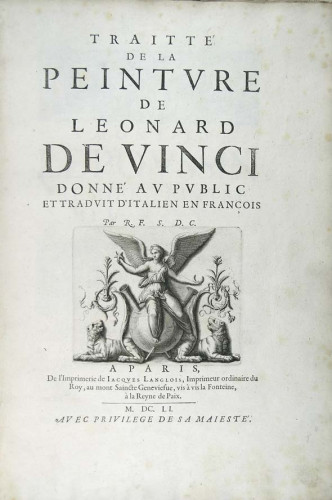
Leonardo da Vinci (1452-1519).
Traitté de la Peintvre de Leonard de Vinci donné av pvblic et tradvit d'Italien en François par R. F. S. D. C. Paris: Jacques Langlois, 1651.
(This volume is part of the Anthony J. and Frances A. Guzzetta Collection of Leonardo da Vinci, Department of Rare Books, Special Collections & Preservation, University of Rochester).
I became interested in collecting books on Leonardo da Vinci after reading the Notebooks of Leonardo da Vinci by MacCurdy several years ago. The notebooks read almost like an encyclopedia, for their subject matter includes art, medicine, mathematics, engineering, naval warfare, sculpture, music, architecture, philosophy, astronomy, botany, and geology. Throughout his notes and illustrations, Leonardo is in fact an outstanding teacher and instructor. He describes in detail every step of his experiments by using drawings. He tells his students what to do, as well as what to avoid. He describes the results as he observes them. (
A. J. Guzzetta, M. D.)
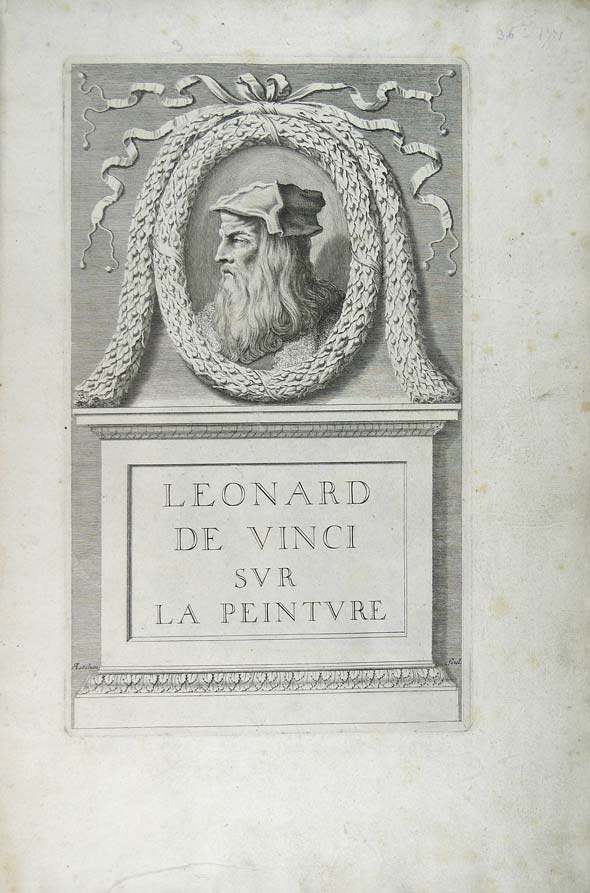
Leonardo da Vinci planned to publish a treatise on painting but he was never able to see his project materialize. His notes on this subject were dispersed in numerous autograph manuscripts written in a span of years from 1490 through 1513. After Leonardo's death in 1519, his papers passed to his friend and pupil Francesco Melzi (1491-c1570). In his attempts to arrange this material into publishable form, Melzi managed to edit the notes on painting from eighteen books, of which only seven and a fragment are extant today. Melzi's compilation, known as the Codex Urbinas Latinus 1270, was the archetype for the abbreviated manuscripts that served as the basis for the first printed editions of Leonardo's Trattato. While the Codex Urbinas contained six books, these abbreviated manuscript versions only included books 2, 3, and 4.(Farago, 2003: 20-52).
Cardinal Francesco Barberini (1597-1679) owned the so-called Codex Barberinus Latinus 4304, the earliest abbreviated copy of the Codex Urbinas Latinus. Cardinal Barberini's library at Rome was a vibrant intellectual centre attracting scholars from all over Europe, especially those interested in the works of Leonardo. Barberini's friend and secretary, Cassiano dal Pozzo (1588-1657), was convinced that knowledge of Leonardo's work on painting was essential to spread proper artistic standards in Rome. For this purpose, he allowed the Codex Barberinus to be copied again and again, commissioning the famous French artist, Nicolas Poussin (1594-1661), for a series of drawings to illustrate Leonardo's Trattato.
Eventually, manuscript copies of the Codex Barberinus traveled to France. Poussin's lifelong patron and friend, Paul Fréart, sieur de Chantelou (1609-1694), brought a copy to Paris. This version can be now identified as the so-called Hermitage manuscript. Annotated by Cassiano himself, it contains the following inscription: "Ce livre ma este donne a Rome au mois d'Aoust 1640 Monsieur le Cavalier del Pozzo au voyage au voyage [sic] que Jy ay fait pour amener en France M. Poussin. Chantelou." This is the manuscript that provided the basis for the editio princeps—strictly speaking, the first printed edition of a work which was transmitted in manuscript form before printing was invented—in 1651. In his introductory letter, the editor, Raphael Trichet du Fresne (1611-1661), explains his sources. First, he mentions the manuscript copy that Cassiano dal Pozzo sent to the printer through Paul Fréart—the Hermitage manuscript. Second, du Fresne refers to a more accurate copy: "the other, which is much more correct, was transmitted through the courtesy of Signor Teuenot, a gentleman versed in all matters of literature and connoisseurship in the arts."
The first printed editions of the Treatise on Painting were published in French and Italian in 1651, 132 years after the death of Leonardo. Both versions were published by Jacques Langlois in Paris. As the Leonardo da Vinci scholar, Victoria Steele, has convincingly argued, the French edition was printed shortly before the Italian one: "the title page of the Italian edition clearly states that it is "Nouamente dato in luce." Furthermore, du Fresne, in his prefatory "Vita di Leonardo", which is found only in the Italian edition, refers to the prior appearance of the French edition: "…il signor di Ciambre n' ha datto una versione in lingua Francese…"" The French translation was by Paul Fréart's brother, Roland Fréart, sieur de Chambray (1606-1676) (Brummer, 1993: 117-125).
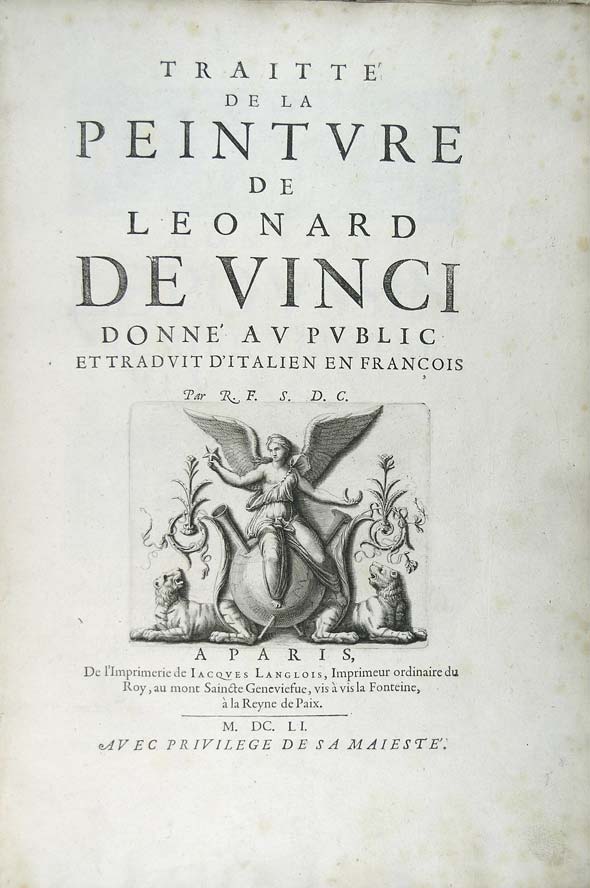
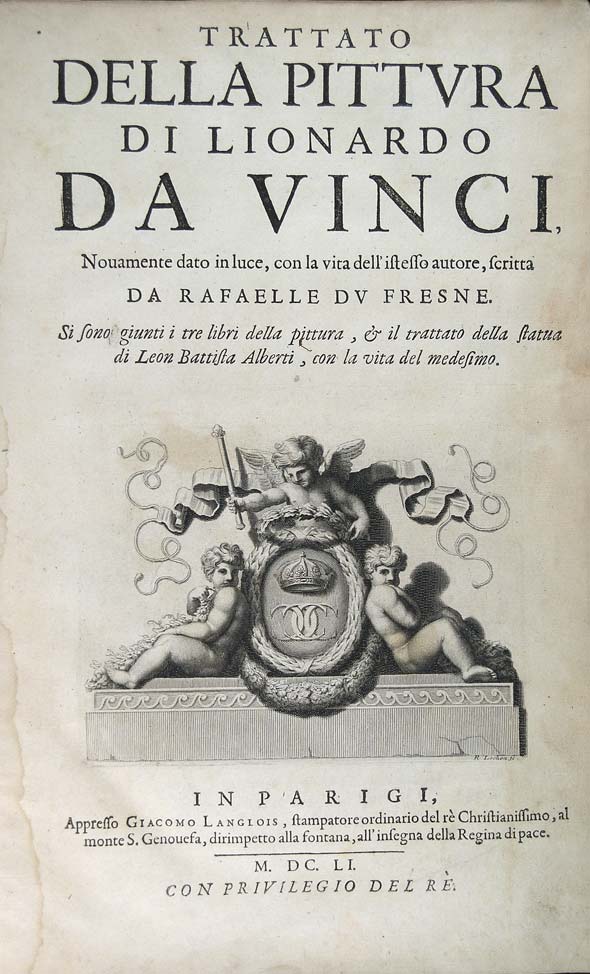
Indeed, the history of the interpretation and transmission of Leonardo's written work is a complex one. Researchers have identified numerous discrepancies between the content of Leonardo's ideas and their interpretation by subsequent scholars. Did the editors of the Codex Urbinas respect the intention of the author? Why write abbreviated versions of Leonardo's Trattato? The complexity of this situation is further exacerbated by the author's use of mirror-image handwriting. For instance, in 1704, the Swiss painter Ludovico Antonio David complained that it took him four hours to read a single page of Leonardo's treatise on hydraulics—now known as the Codex Leicester.
Leonardo's Trattato was intended for an audience of young painters, as he himself states: "Quello che debbe imparar il giovanne." The topics range from practical advice about how to represent the human figure in a particular position, or in motion, to purely scientific theories on light and shadows. However, the fact that many of these ideas, or prescriptions, were still a work in progress allowed the editors of the Codex Urbinas to introduce significant changes in both organization and meaning. For instance, Leonardo originally conceived of perspective as a scientific subject—a branch of optics—in which one can combine the method of deduction from first principles with the observation of nature. On the contrary, the editors of the Codex Urbinas considerably simplified Leonardo's broad approach, merely focusing on specific subjects of representation such as nudes, faces, places, landscapes, etc. Moreover, the order of the passages from Leonardo's notebooks was altered to follow these parameters.
The shortcomings of the first edition were obvious to the seventeen-century reader. Both the editor and the translator were criticized for not being able to address the problems of transmission and interpretation. Overall, there were too many repetitions, contradictions, and obscurities. Today scholars raise more specific questions: How many manuscripts were actually used for this edition? Were they the right ones? Why omit two full books, the first and the fifth? Why include Poussin's drawings, which transformed Leonardo's simple sketches into Graeco-Roman human figures posing in classical attitudes against backgrounds of pastoral landscapes?
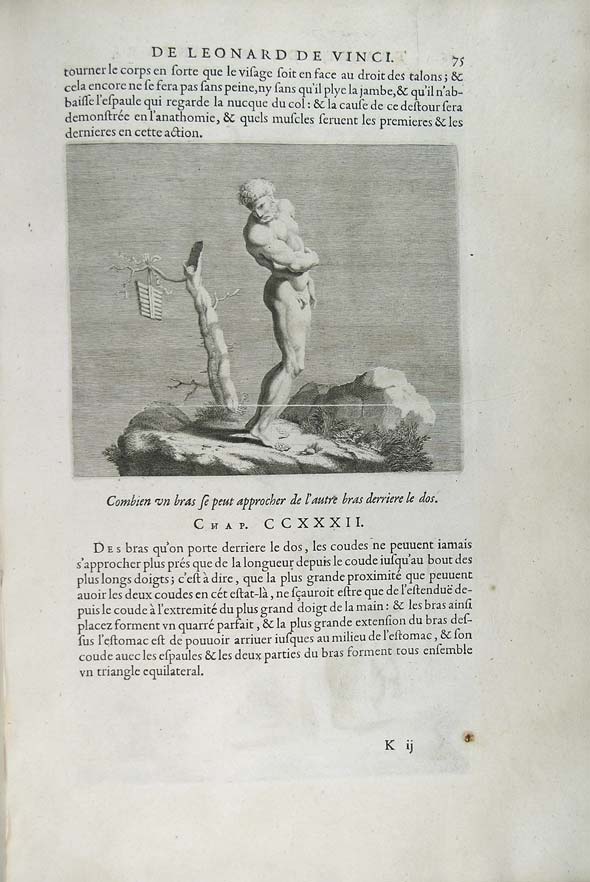
Poussin himself was utterly disappointed with the copperplate engravings of the first edition. In a letter to the engraver and professor of perspective, Abraham Bosse (1602-1676), he states:
"Anything that is good in this book can be written on one sheet of paper in bold characters; and those who believe that I approve everything in it do not know me. For I hold never to give way to things in my profession which I know to be poorly done and poorly expressed."
This statement is certainly odd for we know that Poussin played an important role in the publication of the treatise. In fact, the French translator of the first edition, Roland Fréart, thought it was appropriate to dedicate his translation to Poussin, "the restorer of painting and the ornament of his century." He specifically adds that Poussin "had brought to its highest perfection this rare book, which from now on must be the rule of art and the guide for all painters."
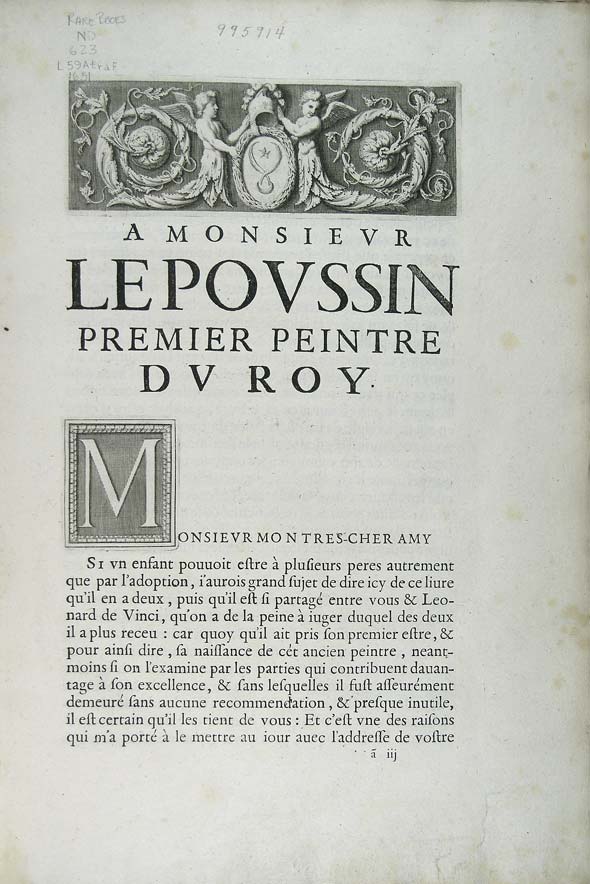
The full significance of Poussin's letter is only understood as we examine some of the intellectual disputes taking place in the Académie Royale de Peinture et de Sculpture. Leonardo's Traité became a contentious subject within the debates on the role of perspective in painting. By the early seventeenth century, major European painters regarded geometrical perspective merely as one of the necessary rudiments of art to be taught to students, rather than as a set of rules playing a central role in artistic composition. Likewise, most French Academicians endorsed this view, emphasizing the painter's intuition to solve the problems of perspective. Conversely, Bosse, who became instructor of perspective in the Royal Academy in 1648, argued that the law of perspective should play a central role in the artist's career. Bosse's ideas were greatly shaped by the engineer, designer, and mathematician, Girard Desargues (1591-1661), who had also been involved in numerous controversies over his views on the different applications of geometry to art, including perspective. The foundation of Desargues' perspective theory was his metrical method in which scales of petit piedsare used to plot on the plane of the picture the locations and dimensions of any given object. Armed with Desargues's ideas, Bosse saw the shortcomings of Leonardo'sTraité as a useful tool to combat his opponents within the academy. Furthermore, by publishing Poussin's letter in his perspective manual, Traité des pratiques géométrales et perspectives: enseignées dans l'Academie royale de la peinture et sculpture (1665), Bosse was clearly turning Poussin into an ally to fight these "perspective wars" (Kemp, 1987: 415-426; Damisch, 2003: 53-61).
Although Leonardo's Traité contains the strong statement that "perspective is the bridle and the rudder of painting," this declaration is not sustained by any specific explanation of the techniques of linear perspective. The Traité simply emphasizes the role of perspective in the artist's earliest studies, a view that perfectly matched the expectations of the Royal Academy. In fact, many of the notions contained in the Traité had been already included in the syllabus of the Academy, particularly the theories about the motion of the human body—the main focus of Poussin's drawings—and the principle of decorum in artistic composition.
One may wonder whether Bosse and Poussin shared the same motives to criticize the Traité. In his letter addressed to Bosse, the painter supplies details about his actual participation in the drawings:
"As for the book by Leonardo da Vinci, it is true that I drew the human figures that are in the copy that belongs to the chevalier du Puis; but all the others, either geometrical or otherwise, are from the hand of a member of the Alberti family, the one who designed the plates in the book on Rome Subterranea and the clumsy landscapes that are behind the small human figures in the copy that was printed by M. de Chambray, were added by a certain Errard, without my knowing anything of it."
This section of the letter helps us understand Poussin's opinion regarding the printed version of the treatise. "A certain Errard" refers to Charles Errard (1606-1689), an illustrator and engraver, who would become the first director of the French Academy in Rome. By adding those "clumsy landscapes" to the human figures drawn by Poussin, Errard completely failed to understand Poussin's interpretation of Leonardo's sketches. Essentially, Poussin concentrated on a small portion of the text dealing with human figures, their movements, the disposition of their members, and their reactions according to particular circumstances, all in relation to the centre of gravity. He was concerned with the basic principle that since every movement implies a disruption of equilibrium, the lack of balance will affect all the parts of the body. Poussin wanted to represent balanced or unbalanced bodies only according to their positions, without the additional reference to a distracting background such as those designed by Errard. In fact, Poussin's original drawings only included a narrow stretch of ground to accompany the human figures.
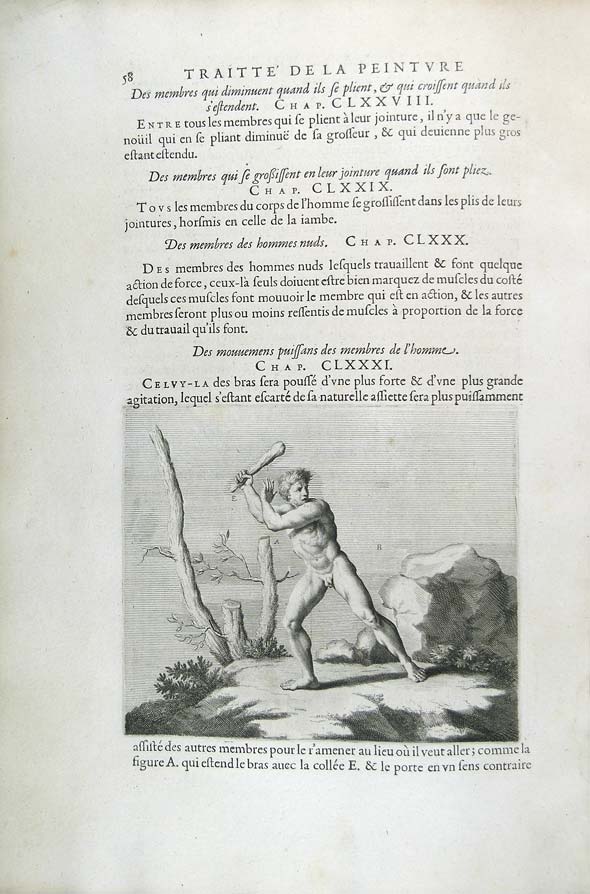
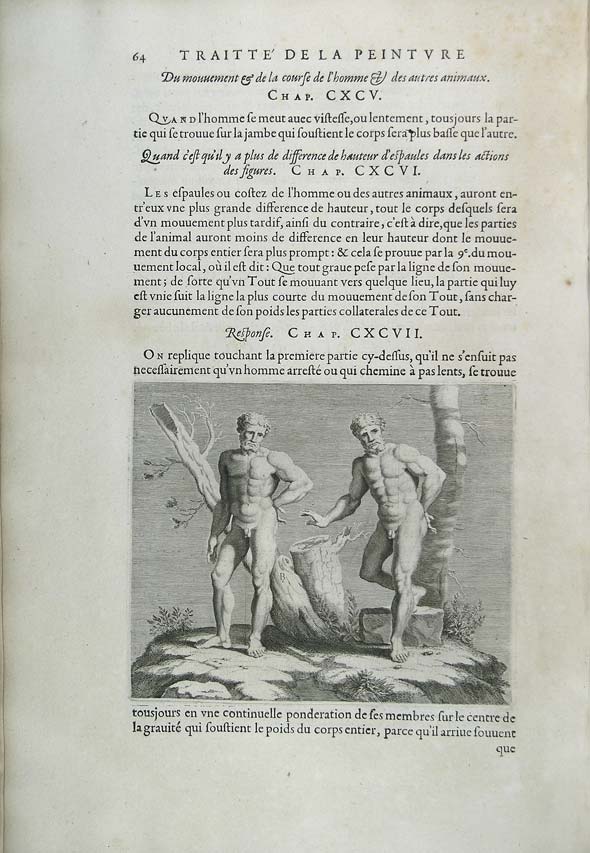
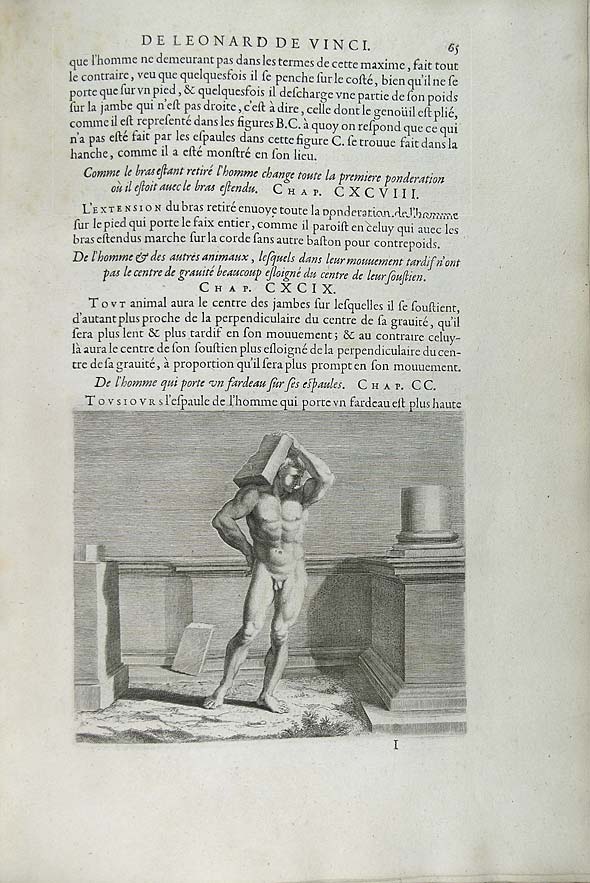
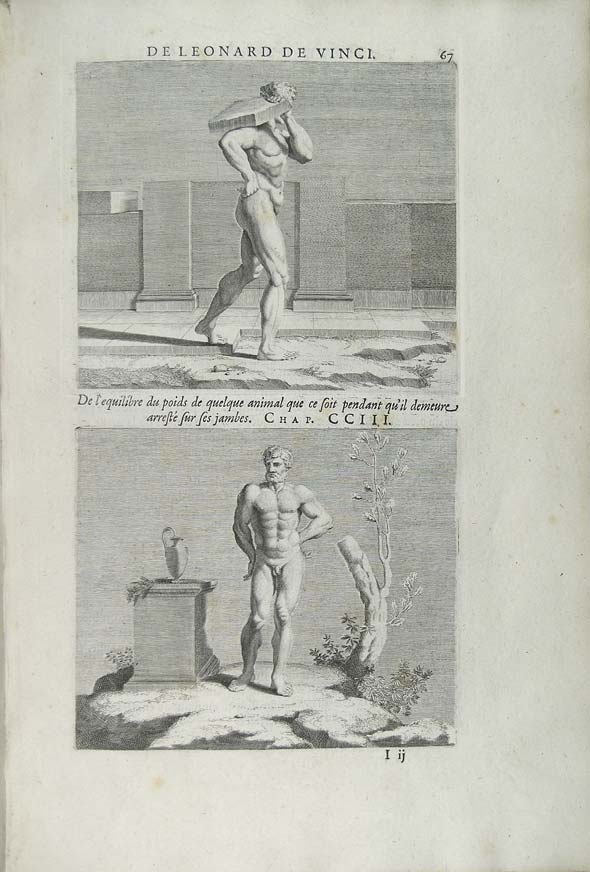
To conclude: this brief essay on the first edition of Leonardo's Trattato della Pittura is ultimately designed to suggest, or exemplify, broader issues dealing with the transmission of texts during the early modern period. As the case of the diffusion of Leonardo's notebooks on painting clearly suggests, the practice of copying and editing manuscript texts did not stop with the introduction of printing in the West by the method of movable type in c.1450. For 132 years, artists, students, and scholars, were happy with using abbreviated manuscript versions of the Trattato for their own purposes. Furthermore, the case of Leonardo is significant in raising questions about the idea of authorship in the sixteenth and seventieth centuries. The example of the 1651 French edition of Leonardo's treatise poses serious doubts about the role of editors and publishers in preserving the original thought of a particular author, making clear that the meaning of a text depends not only on the original intention of its author but also on changes that take place over long periods of time in institutional settings and cultural production.
More information on our Leonardo da Vinci collection can be found in the 1993 Library Bulletin
This blog entry was originally contributed by Pablo Alvarez, Curator of Rare Books at the University of Rochester from 2003 to 2010.
Select Bibliography
The Anthony J. and Frances A. Guzzetta Collection of Leonardo da Vinci. Ed. Margaret Becket. The University of Rochester Library Bulletin 44. New York: University of Rochester Library at Rochester, 1994.
Brummer, Hans Henrik. "The editio princeps of Leonardo da Vinci's Treatise on Painting dedicated to Queen Christina." Achademia Leonardi Vinci: Journal of Leonardo Studies & Bibliography of Vinciana 6 (1993): 117-125.
Damisch, Hubert. "A Tale of Two Sides: Poussin between Leonardo and Desargues." In The Treatise on Perspective: Published and Unpublished, ed. Lyle Massey, 53-61.Studies in the History of Art 59. Washington: National Gallery of Art, 2003.
De Micheli, Mario. "I disegni di Poussin e le incisioni di Errard per l'edizione leonardesca del 1651." Critica d'arte 59, no. 7 (July-September, 1996): 63-71.
Farago, Claire. "How Leonardo da Vinci's Editors Organized His Treatise on Painting and How Leonardo Would Have Done It Differently." In The Treatise on Perspective: Published and Unpublished, ed. Lyle Massey, 20-52. Studies in the History of Art 59. Washington: National Gallery of Art, 2003.
________. Ed. Re-Reading Leonardo: The Treatise on Painting across Europe, 1550-1900. Farnham, England; Burlington, VT: Ashgate, 2009.
Kemp, Martin. "'A Chaos of Intelligence': Leonardo's Traité and the Perspective Wars in the Académie Royale." In "Il se rendit en Italie": Etudes offertes à André Chastel.415-426. Rome: Edizioni dell'Elefante. Paris: Flammarion, 1987.
Pedretti, Carlo. "The Book on Painting: A Bibliography." Achademia Leonardi Vinc: Journal of Leonardo Studies & Bibliography of Vinciana 9 (1996): 165-191.
Steele, Victoria. "The First Italian Printing of Leonardo da Vinci's Treatise on Painting: 1722 or 1733?" Notiziario vinciano 13 no.1 (1980): 3-24.
Steinitz, Kate Trauman. Leonardo da Vinci's Trattato della Pittura: Treatise on Painting. A Bibliography of the Printed Editions 1651-1956. Library Research Monographs. Vol. 5. Copenhagen: Munksgaard, 1958.

